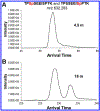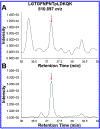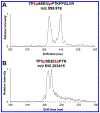Improved Sensitivity and Separations for Phosphopeptides using Online Liquid Chromotography Coupled with Structures for Lossless Ion Manipulations Ion Mobility-Mass Spectrometry
- PMID: 30118596
- PMCID: PMC6211290
- DOI: 10.1021/acs.analchem.8b02397
Improved Sensitivity and Separations for Phosphopeptides using Online Liquid Chromotography Coupled with Structures for Lossless Ion Manipulations Ion Mobility-Mass Spectrometry
Abstract
Phosphoproteomics greatly augments proteomics and holds tremendous potential for insights into the modulation of biological systems for various disease states. However, numerous challenges hinder conventional methods in terms of measurement sensitivity, throughput, quantification, and capabilities for confident phosphopeptide and phosphosite identification. In this work, we report the first example of integrating structures for lossless ion manipulations ion mobility-mass spectrometry (SLIM IM-MS) with online reversed-phase liquid chromatography (LC) to evaluate its potential for addressing the aforementioned challenges. A mixture of 51 heavy-labeled phosphopeptides was analyzed with a SLIM IM module having integrated ion accumulation and long-path separation regions. The SLIM IM-MS provided limits of detection as low as 50-100 pM (50-100 amol/μL) for several phosphopeptides, with the potential for significant further improvements. In addition, conventionally problematic phosphopeptide isomers could be resolved following an 18 m SLIM IM separation. The 2-D LC-IM peak capacity was estimated as ∼9000 for a 90 min LC separation coupled to an 18 m SLIM IM separation, considerably higher than LC alone and providing a basis for both improved identification and quantification, with additional gains projected with the future use of longer path SLIM IM separations. Thus, LC-SLIM IM-MS offers great potential for improving the sensitivity, separation, and throughput of phosphoproteomics analyses.
Conflict of interest statement
The authors declare no competing financial interest.
Figures






Similar articles
-
Nanowell-mediated multidimensional separations combining nanoLC with SLIM IM-MS for rapid, high-peak-capacity proteomic analyses.Anal Bioanal Chem. 2019 Aug;411(21):5363-5372. doi: 10.1007/s00216-018-1452-5. Epub 2018 Nov 5. Anal Bioanal Chem. 2019. PMID: 30397757 Free PMC article.
-
Ultra-High-Resolution Ion Mobility Separations Over Extended Path Lengths and Mobility Ranges Achieved using a Multilevel Structures for Lossless Ion Manipulations Module.Anal Chem. 2020 Jun 2;92(11):7972-7979. doi: 10.1021/acs.analchem.0c01397. Epub 2020 May 22. Anal Chem. 2020. PMID: 32383592 Free PMC article.
-
Serpentine Ultralong Path with Extended Routing (SUPER) High Resolution Traveling Wave Ion Mobility-MS using Structures for Lossless Ion Manipulations.Anal Chem. 2017 Apr 18;89(8):4628-4634. doi: 10.1021/acs.analchem.7b00185. Epub 2017 Apr 5. Anal Chem. 2017. PMID: 28332832 Free PMC article.
-
The Potential for Ion Mobility in Pharmaceutical and Clinical Analyses.Adv Exp Med Biol. 2019;1140:299-316. doi: 10.1007/978-3-030-15950-4_17. Adv Exp Med Biol. 2019. PMID: 31347055 Review.
-
Ion mobility spectrometry and ion mobility-mass spectrometry in clinical chemistry.Adv Clin Chem. 2025;124:123-160. doi: 10.1016/bs.acc.2024.10.003. Epub 2024 Nov 1. Adv Clin Chem. 2025. PMID: 39818435 Review.
Cited by
-
Unraveling the isomeric heterogeneity of glycans: ion mobility separations in structures for lossless ion manipulations.Chem Commun (Camb). 2018 Oct 25;54(83):11701-11704. doi: 10.1039/c8cc06966b. Epub 2018 Sep 28. Chem Commun (Camb). 2018. PMID: 30264832 Free PMC article.
-
Tandem Mass Tag Labeling Facilitates Reversed-Phase Liquid Chromatography-Mass Spectrometry Analysis of Hydrophilic Phosphopeptides.Anal Chem. 2019 Sep 17;91(18):11606-11613. doi: 10.1021/acs.analchem.9b01814. Epub 2019 Aug 28. Anal Chem. 2019. PMID: 31418558 Free PMC article.
-
A streamlined tandem tip-based workflow for sensitive nanoscale phosphoproteomics.Commun Biol. 2023 Jan 18;6(1):70. doi: 10.1038/s42003-022-04400-x. Commun Biol. 2023. PMID: 36653408 Free PMC article.
-
Traveling-Wave-Based Electrodynamic Switch for Concurrent Dual-Polarity Ion Manipulations in Structures for Lossless Ion Manipulations.Anal Chem. 2019 Nov 19;91(22):14712-14718. doi: 10.1021/acs.analchem.9b03987. Epub 2019 Oct 30. Anal Chem. 2019. PMID: 31621288 Free PMC article.
-
Implementation of Ion Mobility Spectrometry-Based Separations in Structures for Lossless Ion Manipulations (SLIM).Methods Mol Biol. 2022;2394:453-469. doi: 10.1007/978-1-0716-1811-0_23. Methods Mol Biol. 2022. PMID: 35094340 Free PMC article.
References
Publication types
MeSH terms
Substances
Grants and funding
LinkOut - more resources
Full Text Sources
Other Literature Sources
Research Materials

